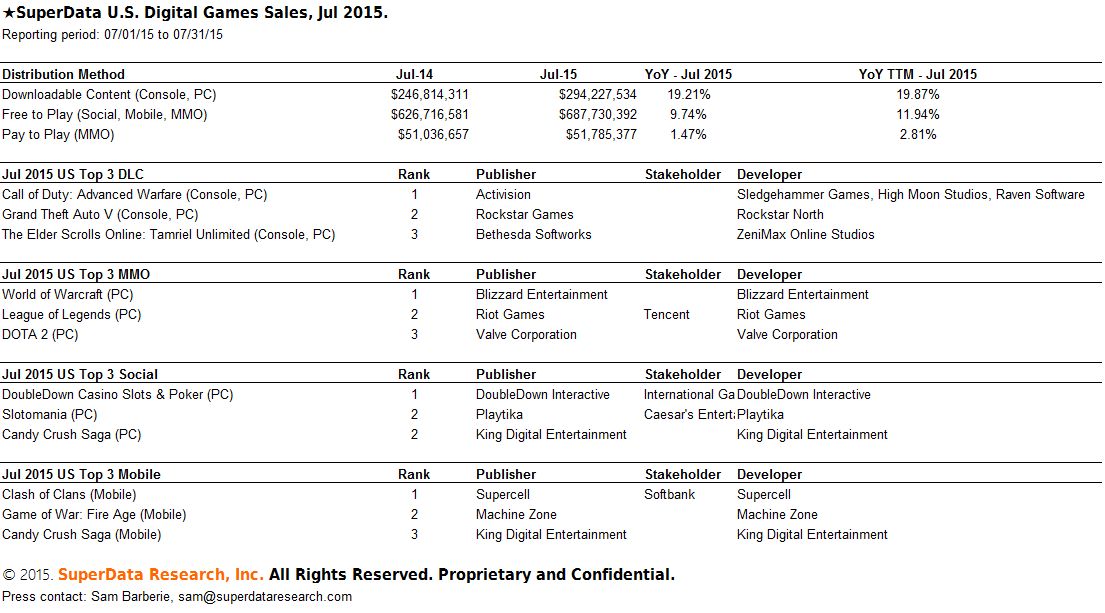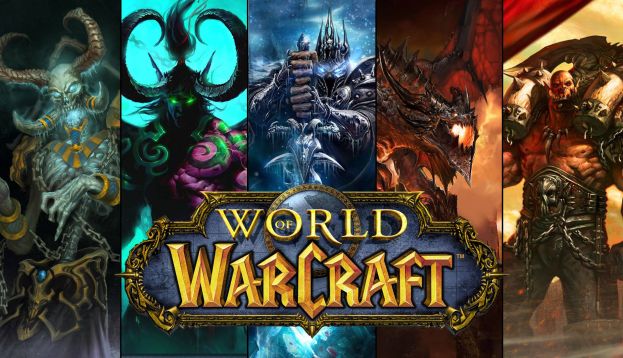Video marketing is booming. Get the insights and knowledge you need to succeed at [a]list Video Summit Aug. 19. Get tix: http://alist.ly/1EVLyyz
Analysis from SuperData CEO, Joost van Dreunen, follows:
- Mobile and downloadable PC games drive 12 percent YoY growth.
- Angry Birds 2 struggles to crack mobile games market.
- Legacy publishers Microsoft and Capcom double down on eSports.
- Startups Kamcord and Mobcrush vie to become the Twitch of mobile gaming.
- Razer buys OUYA in bid for $12.6 billion Chinese digital games market.

Mobile and downloadable PC games drive 12 percent YoY growth in $1.0 billion games market?
Total sales for digital games in the US reached $1.033 billion in July, up 12% from the same month a year earlier. Biggest growth drivers in July were mobile and PC, which combined accounted for about 60% of the total digital games market. Despite a stabilization of the total addressable mobile games audience, average monthly spending has been steadily inching up. And as we reach the high-point in the struggle for platform dominance in the console segment, the last few months have seen increasingly aggressive DLC and free-to-play strategies. This includes, for instance, the July 28 release of World of Tanks on the Xbox One, which supports cross-platform game play. Following the media blitzes at E3 and Gamescom, the industry is now gearing up for the holiday season. Consequently, additional downloadable content dominated over new releases, which were mostly remastered or relatively smaller titles.
Even with 20M downloads Angry Birds 2 struggles to crack mobile games market.
Despite initial optimism, free-to-play mobile game Angry Birds 2 is not yet a commercial triumph. So far, it is still outside of the top 30 highest-grossing games on either the iOS App Store or Google Play despite its stratospheric download numbers. Publisher Rovio was once the top dog on mobile when pay-to-play was the norm and Angry Birds was a steal at $0.99. After switching to a licensing model, the company initially sought to replicate the model that companies like Disney and Nintendo mastered: building a billion dollar empire around highly recognizable franchises. However, as the mobile market has started to saturate, so, too, has Rovio started to see a decline in sales, ultimately resulting in having to lay off 110 late last year. The company’s dependence on a single franchise, and repeated failure to launch something of equal or greater value, continues to undermine its overall market position. Last year, the firm’s games revenue was up 16 percent year-over-year to $121 million, but despite its focus, earnings from consumer products fell 43 percent to $45 million. Releasing Angry Birds 2 was initially planned as a way to reverse its fortunes, but so far the mobile games market has shown itself much less welcoming to the popular franchise than when it first left the nest.
Legacy publishers Microsoft and Capcom double down on eSports.
Last week saw players compete at The International Dota 2 Championships for an $18 million prize pool, the biggest in eSports history. Publishers have long been cultivating competitive gaming as part of their marketing efforts, but only recently did it start receiving mainstream attention. And now console game makers, too, are realizing that having a robust eSports scene deepens the player engagement and retention. So it is no surprise that Microsoft announced a $1 million prize pool for the Halo World Championships, up from the previous total of $150,000. At the same time, Capcom decided to take a page out of the MOBA business model book for one of its most popular franchises. While players are still expected to purchase the game upfront, Street Fighter V will also features characters post-launch, which will be available for purchase with real money or earned by playing. Unlike previous Street Fighter games, Capcom will not release mandatory paid upgrades to the base version of Street Fighter V. With its new monetization strategy, Capcom hopes to easily draw back lapsed players when buzz around the game is strongest during fighting game tournaments like EVO.
Startups Kamcord and Mobcrush vie to be the Twitch of mobile gaming.
July saw mobile gaming live-streaming platform Mobcrush enter open beta, as Kamcord added live-streaming functionality and the ability to record videos to its service. The success of both companies depends less on their ability to pull viewers away from current titans YouTube and Twitch. Instead, it seeks to build an audience that is new to watching gaming video content altogether. The appetite of watching game-related video online has been growing and is currently one of the most popular categories on the internet. According to Matthew Patrick, celebrity YouTuber behind Game Theory with 4.9 million subscribers, “more people watch a video of a game, than play it.” Getting the 270 million mobile gamers in the US to start watching instead of playing does seem like a prudent bet. But we recently found that the current audience for gaming video content is mostly focused on console and PC games, as only 16 percent prefer mobile as their top gaming platform.
Razer buys OUYA in bid for $12.6 billion Chinese digital games market.
Originally coined The People’s Console, OUYA met its end as an independent company after failing to live up to the promise of its wildly successful 2012 Kickstarter. Last year OUYA stopped making its affordable, Android-based microconsole to, instead, focus on putting its digital storefront on other devices. Razer, a manufacturer of high performance mice and keyboards, announced it will soon add OUYA’s store and games library to its own Forge TV microconsole. More importantly, Razer’s purchase will give it a larger presence in China, where OUYA software currently runs on local microconsoles like the Xiaomi Mi Box and Alibaba Tmall Box. Microconsoles have not made a big splash in the West where full-fledged consoles dominate the living room. But low-cost microconsoles from local firms have a better chance to succeed in China. While consoles like the PlayStation 4 and Xbox One are now legally sold in China, their prices are steep for gamers who are used to playing free mobile and PC games. The Chinese games market is on track to generate $12.6B in revenues across digital platforms, up from $11.4 billion last year.

